Driver Installation Procedure
This section describes how to install the software from the supplied Solution Disk in order to process the images imported from your camera.
Windows XP is used as one example in this page, however, Window 2000, Windows Me and Windows 98 SE can also use this installation procedures.
Note:
- Do not connect the camera to your computer until the Solution Disk is unloaded from the computer. With the camera connected, the software will not be installed correctly.
- 2. If you are running Windows XP or Windows 2000, you must first log in as an Administrator (computer system administrator) to install the software.
1. Close all programs that are running.
2. Load the EOS DIGITAL Solution Disk into your computer.
The Installer panel will start automatically.
If the Installer Panel does not appear, use the following instructions to display it.
2-1. Click the [Start] button, and then select [My Computer].
2-2. Right-click the EOS DIGITAL Solution Disk icon, and then select [Open] from the menu that appears.
2-3. Double-click the [Setup] icon.

3. In the Installer Panel, click Install.
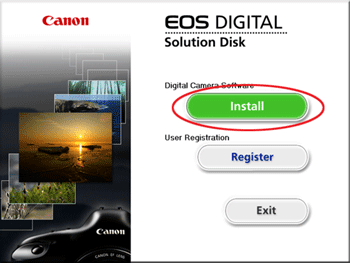
* If a message that prompts you to restart your computer appears, follow the instructions and restart your computer.
4. In the dialog box that appears, click Next.
5. In the [Setup Type] dialog box, select [Easy Installation], and then click [Next].
Select [Easy Installation] because you are installing all the software that are included on the Solution Disk. If you are installing only a specific software, select [Custom Installation], and then specify the software by following the on-screen instructions.
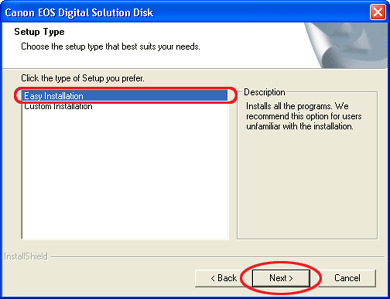
6. Check the details of the License Agreement, and then click [Yes] if you consent to all the conditions.
7. In the [Start Copying Files] dialog box, review the settings of the installation and then click [Next].
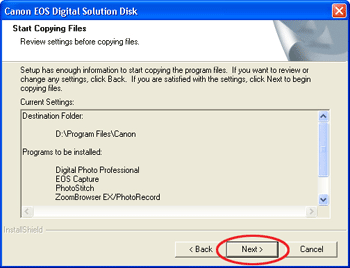
8. When [InstallShield Wizard Complete] dialog box appears, click [Yes, I want to restart my computer now], and then click [Finish].
*The installation will not complete until your computer restarts.

9. Remove the EOS DIGITAL Solution Disk from your computer after the computer restarts.
10. Confirm that the camera is not connected to the computer, and then set the camera's power switch to <ON>.
11. Press the <MENU> button to display the menu and specify the Auto power off settings.
With pressing the <MENU> button, turn the <Quick Control Dial> to select .
11-1. Confirm that [Auto power off] is selected, and then press the <SELECT> button.
11-2. With pressing the <SELECT> button, turn the <Quick Control Dial> to select [Off], and then release the <SELECT> button.
Please refer to the Instruction manual supplied with your camera for more information about the Auto power off settings.
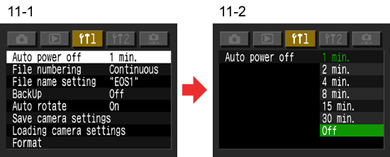
12. Press the <MENU> button and turn off the LCD monitor, and then turn the camera's power switch to <OFF>.
13. Plug the supplied IEEE1394 cable into the IEEE1394 terminal on your computer. The location of the terminal differs between computers. Refer to the documentation provided with your computer for more information.
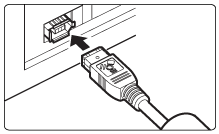
14. Connect the other end of the cable to the <DIGITAL> terminal on the camera.
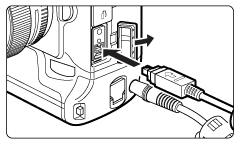
Please note the following things when making the connection using the IEEE1394 cable.
1. Make sure to install the software/drivers from the supplied Solution Disk before connecting the camera to the computer. The computer will not recognize the camera if you make the connection before installing the software/drivers from the solution disk.
2. Avoid doing the following things while running the software installed from the supplied Solution Disk, as these things may cause communications errors.
- Setting the camera's power switch to <OFF>.
- Opening the memory card slot cover.
- Disconnecting the supplied interface cable from the camera or the computer.
- Removing the battery, or disconnecting the AC adapter or DC coupler from the camera.
3. Use only the IEEE1394 cable supplied with your camera to connect the camera to the computer.
4. Do not simultaneously connect multiple cameras to the same computer. The camera may not operate correctly if other cameras are connected to the same computer.
5. Do not let your computer go into standby (sleep) while it is connected to the camera. If your computer goes into the standby mode, wake your computer up while it is still connected to the camera via the IEEE1394 cable.
6. Do not connect the camera to the computer via a hub, or connect multiple IEEE1394 devices to your computer while the camera is connected. These things may prevent the camera from operating correctly.
7. Make sure that the camera's LCD monitor is off before connecting the camera to the computer.
The camera cannot communicate with the computer if the camera's LCD monitor displays menus or images.
15. Set the camera's power switch to <ON>.
If a message such as [Found New Hardware] appears on the lower right corner on the desktop, the installation will be completed when the message disappears automatically.
Your computer may display [Digital signature not found] message depending on the operating systems you are using. If this is the case, Click [Yes] to complete the installation.
If a dialog box showing your camera model name, click [Cancel].
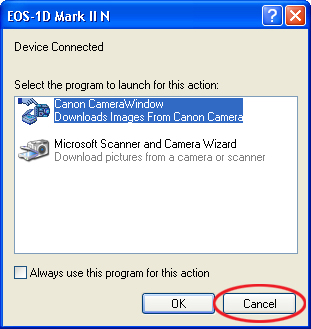
If you are importing images at this point, select [Canon CameraWindow] and then click [OK] in the dialog box shown above.
Do not set the camera's power switch to <OFF> until the installation is completed.
If a message that prompts you to restart your computer appears, follow the instructions and restart your computer.
This completes the installation of the software.